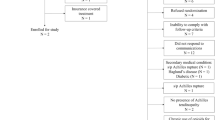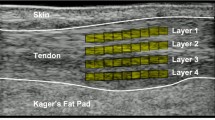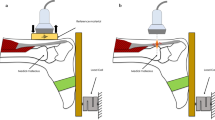Abstract
Objectives
Evaluate the effects of aging on healthy Achilles tendon and aponeurosis shear wave speed (SWS), a quantitative metric which reflects tissue elasticity.
Methods
Shear wave elastography was used to measure spatial variations in Achilles tendon SWS in healthy young (n = 15, 25 ± 4 years), middle-aged (n = 10, 49 ± 4 years) and older (n = 10, 68 ± 5 years) adults. SWS was separately measured in the free Achilles tendon, soleus aponeurosis and gastrocnemius aponeurosis in resting (R), stretched (dorsiflexed 15° from R) and slack (plantarflexed 15° from R) postures.
Results
SWS significantly increased with stretch and varied with age in all tendon regions. Slack free tendon SWS was significantly higher in older adults than young adults (p = 0.025). However, stretched soleus aponeurosis SWS was significantly lower in older adults than young adults (p = 0.01). Stretched gastrocnemius aponeurosis SWS was significantly lower in both middle-aged (p = 0.003) and older (p = 0.001) adults, relative to younger adults.
Conclusion
These results suggest that aging alters spatial variations in Achilles tendon elasticity, which could alter deformations within the triceps surae muscle–tendon units, thus affecting injury potential. The observed location- and posture-dependent variations highlight the importance of controlling ankle posture and imaging location when using shear wave approaches clinically to evaluate tendon disorders.
Key Points
• Shear wave elastography shows promise as a clinical quantitative ultrasound-based technique.
• Aging induces location-dependent changes in Achilles tendon shear wave speed.
• Spatial and postural dependence necessitates careful integration of this approach clinically.





Similar content being viewed by others
References
Alfredson H (2003) Chronic midportion Achilles tendinopathy: an update on research and treatment. Clin Sports Med 22:727–741
Thorpe CT, Udeze CP, Birch HL et al (2013) Capacity for sliding between tendon fascicles decreases with ageing in injury prone equine tendons: a possible mechanism for age-related tendinopathy? Eur Cell Mater 25:48–60
Couppe C, Hansen P, Kongsgaard M et al (2009) Mechanical properties and collagen cross-linking of the patellar tendon in old and young men. J Appl Physiol 107:880–886
Viidik A (1979) Connective tissues - possible implications of the temporal changes for the aging process. Mech Ageing Dev 9:267–285
Patterson-Kane JC, Parry DA, Birch HL et al (1997) An age-related study of morphology and cross-link composition of collagen fibrils in the digital flexor tendons of young thoroughbred horses. Connect Tissue Res 36:253–260
Csapo R, Malis V, Hodgson J, Sinha S (2014) Age-related greater Achilles tendon compliance is not associated with larger plantar flexor muscle fascicle strains in senior women. J Appl Physiol 116:961–969
Onambele GL, Narici MV, Maganaris CN (2006) Calf muscle-tendon properties and postural balance in old age. J Appl Physiol 100:2048–2056
Stenroth L, Peltonen J, Cronin NJ et al (2012) Age-related differences in Achilles tendon properties and triceps surae muscle architecture in vivo. J Appl Physiol 113:1537–1544
Kubo K, Morimoto M, Komuro T et al (2007) Age-related differences in the properties of the plantar flexor muscles and tendons. Med Sci Sports Exerc 39:541–547
Wood LK, Arruda EM, Brooks SV (2011) Regional stiffening with aging in tibialis anterior tendons of mice occurs independent of changes in collagen fibril morphology. J Appl Physiol 111:999–1006
Slane LC, DeWall RJ, Martin JA, Lee KS, Thelen DG (2015) Middle-aged adults exhibit altered spatial variations in Achilles tendon wave speed. Physiol Meas 36:1485–1496
DeWall RJ, Slane L, Lee KS, Thelen DG (2014) Spatial variations in Achilles tendon shear wave speed. J Biomech 47:2685–2692
Arruda EM, Calve S, Dennis RG et al (2006) Regional variation of tibialis anterior tendon mechanics is lost following denervation. J Appl Physiol 101:1113–1117
Pearson SJ, Ritchings T, Mohamed ASA (2014) Regional strain variations in the human patellar tendon. Med Sci Sports Exerc 46:1343–1351
De Zordo T, Fink C, Feuchtner GM et al (2009) Real-time sonoelastography findings in healthy Achilles tendons. AJR Am J Roentgenol 193:W134–W138
Thorpe CT, Udeze CP, Birch HL et al (2012) Specialization of tendon mechanical properties results from interfascicular differences. J R Soc Interface 9:3108–3117
Ooi CC, Richards PJ, Maffulli N et al (2015) A soft patellar tendon on ultrasound elastography is associated with pain and functional deficit in volleyball players. J Sci Med Sport. doi:10.1016/j.jsams.2015.06.003
Klauser AS, Miyamoto H, Tamegger M et al (2013) Achilles tendon assessed with sonoelastography: histologic agreement. Radiology 267:837–842
De Zordo T, Lill SR, Fink C et al (2009) Real-time sonoelastography of lateral epicondylitis: comparison of findings between patients and healthy volunteers. Am J Roentgenol 193:180–185
De Zordo T, Chhem R, Smekal V et al (2010) Real-time sonoelastography: findings in patients with symptomatic Achilles tendons and comparison to healthy volunteers. Ultraschall der Medizin 31:394–400
Ooi CC, Malliaras P, Schneider ME, Connell DA (2014) “Soft, hard, or just right?” Applications and limitations of axial-strain sonoelastography and shear-wave elastography in the assessment of tendon injuries. Skelet Radiol 43:1–12
Lacourpaille L, Hug F, Bouillard K et al (2012) Supersonic shear imaging provides a reliable measurement of resting muscle shear elastic modulus. Physiol Meas 33:N19–N28
Bercoff J, Tanter M, Fink M (2004) Supersonic shear imaging: a new technique for soft tissue elasticity mapping. IEEE Trans Ultrason Ferroelectr Freq Control 51:396–409
Brum J, Bernal M, Gennisson JL, Tanter M (2014) In vivo evaluation of the elastic anisotropy of the human Achilles tendon using shear wave dispersion analysis. Phys Med Biol 59:505–523
Eby SF, Song P, Chen S et al (2013) Validation of shear wave elastography in skeletal muscle. J Biomech 46:2381–2387
Bavu E, Gennisson JL, Couade M et al (2011) Noninvasive in vivo liver fibrosis evaluation using supersonic shear imaging: a clinical study on 113 hepatitis C virus patients. Ultrasound Med Biol 37:1361–1373
Arda K, Ciledag N, Aktas E et al (2011) Quantitative assessment of normal soft-tissue elasticity using shear-wave ultrasound elastography. Am J Roentgenol 197:532–536
Aubry S, Nueffer JP, Tanter M et al (2014) Viscoelasticity in Achilles tendonopathy: quantitative assessment by using real-time shear-wave elastography. Radiology. doi:10.1148/radiol.14140434
Aubry S, Risson JR, Kastler A et al (2013) Biomechanical properties of the calcaneal tendon in vivo assessed by transient shear wave elastography. Skelet Radiol 42:1143–1150
Hug F, Lacourpaille L, Maisetti O, Nordez A (2013) Slack length of gastrocnemius medialis and Achilles tendon occurs at different ankle angles. J Biomech 46:2534–2538
Hawkins D, Lum C, Gaydos D, Dunning R (2009) Dynamic creep and pre-conditioning of the Achilles tendon in-vivo. J Biomech 42:2813–2817
Kuo P-L, Li P-C, Li M-L (2001) Elastic properties of tendon measured by two different approaches. Ultrasound Med Biol 27:1275–1284
Royer D, Gennisson JL, Deffieux T, Tanter M (2011) On the elasticity of transverse isotropic soft tissues. J Acoust Soc Am 129:2757–2760
Patterson-Kane JC, Firth EC, Goodship AE, Parry DA (1997) Age-related differences in collagen crimp patterns in the superficial digital flexor tendon core region of untrained horses. Aust Vet J 75:39–44
Turan A, Teber MA, Yakut ZI et al (2015) Sonoelastographıc assessment of the age-related changes of the Achilles tendon. Med Ultrason 17:58–61
Karamanidis K, Arampatzis A (2005) Mechanical and morphological properties of different muscle-tendon units in the lower extremity and running mechanics: effect of aging and physical activity. J Exp Biol 208:3907–3923
Epstein M, Wong M, Herzog W (2006) Should tendon and aponeurosis be considered in series? J Biomech 39:2020–2025
Blevins FT, Hecker AT, Bigler GT et al (1994) The effects of donor age and strain rate on the biomechanical properties of bone-patellar tendon-bone allografts. Am J Sports Med 22:328–333
Vogel HG (1980) Influence of maturation and aging on mechanical and biochemical properties of connective tissue in rats. Mech Ageing Dev 14:283–292
Mckean KA, Manson NA, Stanish WD (2006) Musculoskeletal injury in the masters runners. Clin J Sport Med 16:149–154
Astrom M, Rausing A (1995) Chronic Achilles tendinopathy. A survey of surgical and histopathologic findings. Clin Orthop Relat Res 316:151–164
Garrett WE (1990) Muscle strain injuries - clinical and basic aspects. Med Sci Sports Exerc 22:436–443
Kirkendall DT, Garrett WE (2002) Clinical perspectives regarding eccentric muscle injury. Clin Orthop Relat Res S81–S89
Speer KP, Lohnes J, Garrett WE Jr (1993) Radiographic imaging of muscle strain injury. Am J Sports Med 21:89–95, discussion 96
Dewall RJ, Jiang J, Wilson J, Lee KS (2014) Visualizing tendon elasticity in an ex vivo partial tear model. Ultrasound Med Biol 40:158–167
Barbosa DC, Bamber JC, Cosgrove DO, Nassiri D (1986) Ultrasound attenuation measurements to assess the progress of malignant-tumors. Br J Radiol 59:742
Havre RF, Elde E, Gilja OH et al (2008) Freehand real-time elastography: impact of scanning parameters on image quality and in vitro intra- and interobserver validations. Ultrasound Med Biol 34:1638–1650
Acknowledgments
The scientific guarantor of this publication is Dr. Kenneth Lee. The authors of this manuscript declare no relationships with any companies whose products or services may be related to the subject matter of the article. This study received funding from the Radiological Society of North America (Scholar Grant), the University of Wisconsin-Madison Radiology Department Research and Development Fund (#1204-001), and the Clinical and Translational Science Award (CTSA) program, previously through the National Center for Research Resources (NCRR) grant 1UL1RR025011, and now by the National Center for Advancing Translational Sciences (NCATS), grant 9U54TR000021. No complex statistical methods were necessary for this paper. Institutional review board approval was obtained. Written informed consent was obtained from all subjects (patients) in this study. Some study subjects or cohorts have been previously reported in Physiological Measurement (12) and the Journal of Biomechanics (11). The study was prospective, cross-sectional and performed at one institution.
Author information
Authors and Affiliations
Corresponding author
Rights and permissions
About this article
Cite this article
Slane, L.C., Martin, J., DeWall, R. et al. Quantitative ultrasound mapping of regional variations in shear wave speeds of the aging Achilles tendon. Eur Radiol 27, 474–482 (2017). https://doi.org/10.1007/s00330-016-4409-0
Received:
Revised:
Accepted:
Published:
Issue Date:
DOI: https://doi.org/10.1007/s00330-016-4409-0




